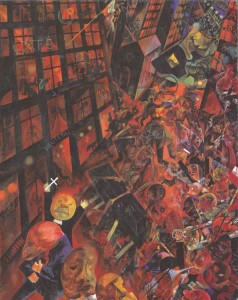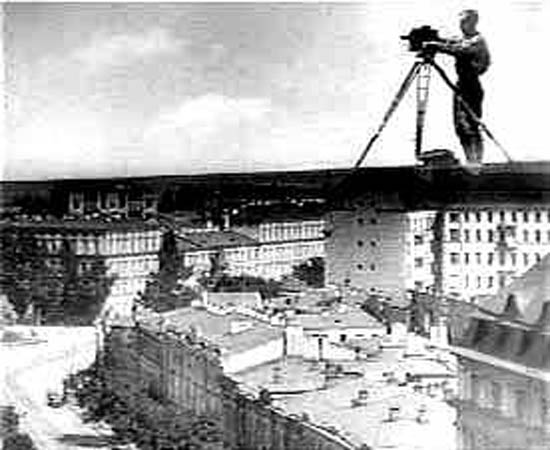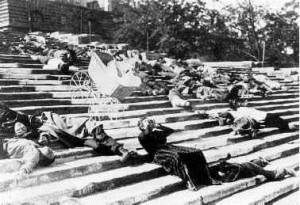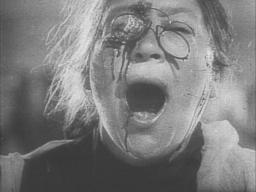WEIMAR SUBJECTIVITY AFTER THE FIRST WORLD WAR
As a Russian Jew, I often thought why I always associated Berlin with Nazism and Communism. There was clearly a bias. Now, I have a new opinion. Having gone on extensive walking tours of Berlin with a cultural studies-history-professor-lecturer from the American University of Paris—wherein he narrated to us actual historical events that took place there, I was jokingly told the following adage: Berlin “is a city that never is, but is always becoming.” I was taken aback. Germany, as a country, did not even exist until 1871. Why was there so much progress in so little time? What happened between World War I and World War II? Wasn’t Weimar Berlin, in fact, the most socially-conscious, libertine extravaganza that trumped even Paris as the cultural heart of Europe? Yes. Those who lived there knew. But why?
I became so interested in the art between the Russian Revolution and the Weimar Epoch, it consumed me. Quite simply, it was an exciting time to be alive. Given that World War I was the first fully mechanized war—the first truly “modern” war, it cannot be stressed enough how technology, particularly as relates to the mechanization of subjectivity, inspires and nurtures particular cultural trends which invariable characterize the Weimar Berlin. The vibrancy of Berlin, then, the cultural supernova that was Weimar Berlin, cannot be conceived merely as a political-economic field upon which “artistic events” took place. There was a collective mood following the First World War, a zeitgeist. That is, it was a place where Germany’s psychic wounds, its disillusionment and loss could be healed. Consequently, the harsh sanctions affecting Germany as whole—as outlined in the Treaty of Versailles—left Berlin’s citizens in a position to re-coordinate the meaning of their culture, and, moreover, their being-in-the world. The Macbethian specters looming in Berlin during the Weimar Republic entailed an obtrusive annihilation, a collective guilt, perhaps, or shame, at the subjective level. The war was over. Troops came home, though the spiritual consequences of the conflict, at the geopolitical level, at the national level, and at the urban level, had yet to become fully realized. The collective tension, then, to put it naively, forced many Germans to contend with their place in the world, either actively or passively.
Naturally, art was both a symptom and an antidote to the post-WWI condition.
I will use Heidegger’s understanding of the metaphysics of art to illustrate both how both belief systems, in tension with one another ideologically, are expressed in Berlin while Germany attempted to regenerate the meaning of its own Being. I wish to explicate, in particular, how the “clearing” or Lichtung produced by Weimar epoch—as expressed by Russian émigré and Berliner art alike, support Heidegger’s claims. Russian émigrés, as it well known, contributed to the culture of the Weimar Republic. Their political own unease strongly resembles the main premises of Heidegger’s thesis—namely that the tension between earth and world as it relates to technology, is a necessary condition for the re-invention of the modern self. This tension, however, illuminates not only the psychic displacement of Berliners, but also reinforces the notion that Russian émigré art was just as pertinent to the mood of Berlin as its own native artists.
Along those lines, two movements, National Socialism and Communism, have, to some degree, been emblematic of the search for man’s being to re-defined. They are, at least in loose sense, reactions to nihilism. Emptiness and disillusionment, as situated in the nebulous psychic climate of Weimar Berlin is emblematic of its vibrancy. But what is ironic about this vibrancy is what lies behind it. Nazism, after all, in effect, requires, as a condition, a certain belief in a charismatic leader, a personal savior-father-figure. Communism, on the other hand, also entails a certain belief: that is, that the historical necessity of a paradigm can actualize collective salvation. In short, both these ideologies attempt to not only “save mankind” from itself, but to re-define his being.
I want to confront the two-pronged “salvations” evident in the art of Weimar Berlin.
There are two main “strains” of art equally characteristic of Weimar—to put it bluntly, the political kind and the apolitical kind. It is important to discern how these “strains” played out in the art scene itself. Grosz, the painter, for example, known for his political cartooning proved to push the limits of realism by rendering a peculiar synthetic madness in his work. He consciously distorted human proportions, and, to brought in manneristic elements to it.
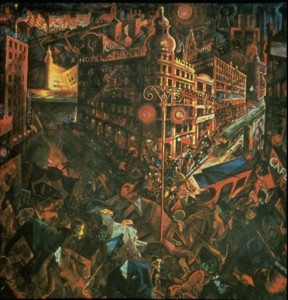
The perspective in his cartoons is often intemperate; figures are jammed into small, dark spaces, illumined by candlelight.
There is play between light-shadow, subtlety-grandeur, contemplation-emotion; then tone is blotched. Human bodies and faces are contorted, longing for something unclear.
It is the composition’s wholeness, then, its totality, in and of itself, that is of utmost importance. Grosz himself admits his work attempts to capture the despair indicative of the political coordinates in which he lived:
My drawings expressed by despair, hate, and disillusionment. . .I drew drunkards; puking men; men with clenched fists cursing at the moon. . . I drew lonely little men fleeing madly through empty streets. . . .I drew soldiers without noses; war cripples with crustacean-like steel arms” (Friedrich 37).
Grosz makes his panache for distortion abundantly clear. There is an ordering principle to the distortion itself. Despair as such is couched in intoxication; frailty, in the steeliness of Weimar arms. In this light, the extreme pressure on Germany to fulfill its war-time debts is ironically analogous with the inspiration to burst itself.
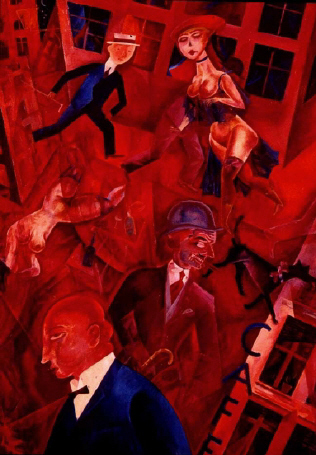
Along those lines, consider “Interwar” (Dedicated to Oscar Panizza) . The composition, most likely, is spryly held together—almost to the point of bursting off the canvas. The work aims at generating awe.
Beckman, for example, was also concerned with the “orgiastic” disillusionment felt by Berliner’s during the Weimar period. His work, however, is different from Grosz’s. in that he was not as overtly political, rather he was concerned with capturing the consequences of reification as found in the German psyche. There is a peculiar morose decadence in “The Night.”
It is important to remember there was, both a lack of order during the Weimar period, and a need for order, especially at politically level. Assassinations abounded. And after the assassination of Rathethau it was apparent that the differing points of view regarding how Germany was to deal with its financial burden oscillated within the same temporal axis that promoted its psychic economy.
Otto Dix’s painting “Streichholzhändler“ is an excellent example of such an oscillation.
As Heidegger writes, “man, who no longer conceals his character of being the most important raw material, is also drawn into this process (EP 104, VA 190). That is to say, the technological dynamism of the Great War itself, both directly and indirectly inspires Grosz, Beckman, and Dix’s subject manner. For in many respects, all of these artists depict the annihilation of man’s subjective disposition. They, in effect, attempt to capture the relation to the totalizing power of technology, which calls into question the man’s efficiency to forces he cannot control and is altogether subsumed by.
And yet, there is peculiar chaos inherent in all of these artists work as well: a certain need to re-organize the disillusionment itself, to escape from nihilism, and introduce a new level of understanding in regards to what it means to be a modern subject at all. This is why, for such artists, art can be considered “political.” For their subject matter deals with not only what technology has done to man’s being, but how Berlin’s political disillusionment itself facilitates the need to overcome its nihilism.
In the case of the great avant-gardes of this period, most notably expressed by Russian constructivism and Cubo-Futurism, there is also an encounter between man and technology. However, Pre-Revolutionary idealism (as opposed to Russian émigré literature), was more or less underscored by the “power of the notion”—that is, the belief in a seamless machine-like utopia, which would reshape how the Russian people saw themselves.
Consider Malevich’s “Knife-Grinder,” painted only a decade before the Weimar period—
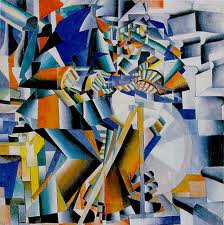
Here, the power of the individual stands at a paradoxical leaping point regarding his own being: on one hand, he is superior to nature, on the other, his moral agency is independent of nature because man had his own nature. The knife-grinder, then, like the Grosz, or Beckman, or Dix’s political mannerism is also subsumed by technology, but through its content, not its form. In this sense, it should come as no surprise that Malevich blended the knife-cutter into the background, that is to say, not only in tone and color, but in terms of dimensionality as well.
The tension between dimensionality, indicative of the relationship between man and machine, then, lays bear the startling difference between “Russian avant-garde” art and Weimar art. Some degree, one could posit that the “apolitical” is politicized in the case of former; and that the political is apolicized in the case of the latter. But this would be putting it crudely, for the implications of what a Utopian vision means (as a redefinition of man’s being) in the case of pre-Revolutionary art, differs greatly from what a Dystopian disillusionment means for him. The extent of technology’s gripping affect on man depends wholeheartedly on where one’s “being-is-in-time” is situated. In this sense it is not presumptuous to infer why Russian émigré literature differs so much from pre-Revolutionary art. The Soviet Union, after all, was too new for anyone to concretely postulate what it was to become.
THE INFLUENCE OF RUSSIAN ÉMIGRÉS IN BERLIN AFTER THE RUSSIAN REVOLUTION
By the middle of 1921, however, a million Russian refugees fled the revolution and its aftermath. Some settled in Harbin or Shanghai or crossed to the United States. Most stayed in Europe, congregating in Paris, Prague, and Berlin, or to a lesser extent in Riga and Sofia. As prices rose sharply in France late in 1921, however, émigrés deserted Paris for center of the emigration. It was in these heady years of émigré life, that the Soviet citizens under the NEP conditions could to travel more freely. abroad gravitated to Berlin.
At every step, you could hear Russian spoken. Dozen of Russian restaurants were opened— Three daily newspapers and five weeklies appeared in Russia. In one year seventeen Russian publishing firms were started” (Friedrich 82).
For a brief period in 1921-1922 the boundaries between the emigration and Soviet Russia seemed to some rather blurred. As Simon Karlinksy wrote:
Russian émigré literature as a phenomena distinct from Soviet literature had not yet come into existence. The offices of Berlin publishers and the literary cafes frequented by Russians provided a meeting ground for writers who had aligned themselves the Soviet regime, those who were opposed to it. . . and those who were still undecided.
In this regard, it is important to bear in mind that there was no transition from war to Revolution for the Russian people. Here, the temporal displacement of Russian artists living in Berlin, is made apparent. For this reason, Brian Boyd correctly points out the implications of a past/present bifurcation inherent in Vladmir Nabokov’s first novel, Mashen’ka:
time, not space, is Nabokov’s real subject: not the Russian Berlin the book renders so well, but the accumulated time of memory that allows Ganin to superimpose the country of his past on the city streets of his present” (Boyd 248).
Along those lines, it appears as if Berlin itself, with its own tension between world and earth—that is to say, the tension between the totalizing power of mechanization and its consequences, and the ineffable Beingness in need of redefinition during the Weimar period—facilitated the very need for a Russian transition. Perhaps this why Nabokov’s work deals primarily with the relationship between aesthetics and ethics more than politics, more than man versus machine. For there is forces much higher than politics, higher than nationality, higher than historical context. In this sense Weimar art and Russian émigré art alike, share a considerable interest in a supersensible reality, in a spiritual reality, just as much as expressing one’s disillusion with history itself.
BIZZARRO KINGDOMS, METAPHYSICAL FUSIONS AND THE ADVENT OF FILM MONTAGE
Visual art as well as literature, then, in Weimar Berlin, ran a two-pronged course. It attempted to not only to postulate the awareness of man’s being next to his historical inevitability, but, in affect, rendered his spiritual concerns which were in tension with that inevitability itself. Weimar art, then, in general, was concerned with the totalizing power of the world, the ordering principle reacting to nihilism-as well as with what Heidegger suggests, is indicative of earth—-namely something which entails the inexplicable feature of being-in-the-world. Weimar art, then,was highly concerned with the totalizing power of Heidegger’s concept of world, the ordering and over-encompassing principle reacting to nihilism—-as well as with what Heidegger suggests, is indicative of earth—-namely something which entails the inexplicable feature of being-in-the-world in general
Naturally, one cannot help but ignore the great film directors of the era, namely, Fritz Lang, Vertov, and Eisenstein. Metropolis, for example, hailed by critics world-wide to this day, is a film which uses technology in effort to critique the mechanization of human agency itself.
His work, as such, is particularly emblematic of the Heideggerian distinction I have so far been explicating, between that of world and earth. The film is about a dystopia, yes, but is about much more than that: there is poetic desperation in the film’s tone, a frailty generated by the use of a movie camera itself, particularly in respect to the content of film.
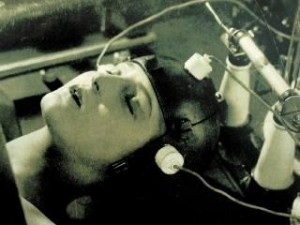
After all, the film captures a peculiar mood, a strange one at that— a certain ambivalence, that is, on the part of the inhabitants of the metropolis.
In this regard, Lang seems to be painfully aware of the need to re-order the understanding in man’s being. The cyborg-princess is the film is nothing less than a melancholy figure. We, as viewers, however, anthropomorphize her in order to sympathize with the conditions which provoke her existence.
Similarly, Vertov’s work, in the film, ‘Man with a Movie Camera” also seems to capture a general pathos regarding man’s relationship to machine—man is a machine, an unapologetically so, for the only way to capture man’s being is by implementing tools in which he can re-order the implications of using them.
Eisenstein’s use of montage has a profound influence. By manipulating images, pitting one frame against another seemingly unrelated frame, he is creating a third image.
Battleship Potemkin (1925)
Battleship Potemkin, same scene only seconds later (1925)
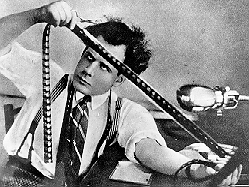
But this third image (not my own feeble example) takes in a conceptual frame, in the mind of the viewer. We deduce the tension, the collision, as it were, between the mechanization of the images and the conceptual meaning of images sutured together. In this vein, the “cut,” the blank space between two concurrent images, (a split-second black frame with nothing on it), represents the both the empirical actuality of man’s nothingness, his being-in-the world, as well as the ability for man’s being as such to re-appropriate this very nothingness, and posit a new meaning in its place. Man is both with the world and against it. Something eludes his understanding, but it can be sensed, spiritually, non-mechanically.
Along those lines, it important to see how emphasizing the internal experience of man’s being, both characterized by the Russian émigré artists and the Weimar artists, operates in terms of politics. After all, if, as I have suggested it is possible that some art was wholly apolitical in the Weimar Era, does this suggest a kind of political apathy, even a irresponsibility on the part of the artist himself? Perhaps. Franze Werfel, for example, wrote the following during the war:
I cannot describe how contradictory to me are the concepts poetry and politics! The politician looks at life coldly; the evil of power has triumphed over him. The writer. . .is endlessly destructive, immeasurably anarchistic. . .He dare not blow the trumpet for the revolution. He storms other bastilles, O irresistible dynamite of insight! (Lange 96).
But after the war, this sentiment was still running rampant in Berlin. As Gordon Craig points out, the emphasis on Innerlichkeit, which “regarded the external world at its works as being of no legitimate concern to the artists. . . made aesthetic contemplation and intellectual activity ends in themselves” (Craig 49). This means that the elements of supranational self, which is primarily concerned with being-in-the-world independent of the worldliness of man’s situation, was characterized by delving into aesthetic paradigms that upheld political neutrality.
This indifference, in turn, was in a nuanced version of the experience of Russian émigré artists and writers living in Berlin. After all, it would be quite fallacious to presume émigrés were of one political persuasion over another. Both conservative and liberal émigrés lived in Berlin during the Weimar period, but it was not until 1922, during the expulsion of over 160 important Russian dissidents, that Berlin, could be considered the emblematic city of in the what is now called “Changing Landmarks.” In this sense, Berlin’s own political hostility was, to some degree, mellowed out by the cultural enthusiasm of the liberal émigrés themselves. They, too, had hopes for a new future, but not necessarily a political one. The main factors, indeed, were economic. Those Russians who fled during the Revolution, living in Paris, Prague and the Balkans, flocked now to Berlin. It was invariably cheaper, and it wasn’t until inflation hit and political unrest was absolutely apparent that they decided to move on. “There was,” as Williams writes, “also by this time. . .a certain mood of reconciliation within the intellectual colony in Germany and elsewhere in the diaspora, of which the chorus of romantic slogans about ‘the East’ was one symptom” (582).
Berlin, then, seems to have served as a clearing place for émigrés both on the left and on the right. Berlin might have very well become “a center where émigrés recently expelled from Russia met other émigrés on their way back: [in] a “crossing of ways,” but their temporal displacement from their home, their search to find meaning in their lives, differed greatly with the problems of the Weimar Republic itself, with both the political apathy and invigoration of the Berliner’s living there.
In this respect, the Expressionist movement, which, for the most part, was “not only inexperienced in politics but anti-political by conviction” appears to be a paradox. For there is a tension not only between the apolitical approach to art, which is a reaction to the technological horrors of WWI, but the very fact that restructuring man’s being as “an expression of subjective forces” can equally mechanize him. That said, apolitical art is precisely as nihilistic as the conditions that provoke it to exist. If Heidegger is correct, the ability to receive an new understanding of what technology does to us, in relation to our being, is more important than appropriating our own political inertia (to do nothing).

As Hubert Dreyfus, Heidegger scholar, points out:
once we realize—in our practices, of course, not just as matter of reflection—that we receive our technological understanding of being, we have stepped out of the technological understanding of being, for we then wee that what is more important is not subject to efficient enhancement –indeed, the drive to control everything is precisely what we do not control.
In this sense, pure contemplation of the interiority of man’s condition, as found in Expressionism, is invariably fruitless. Gottfried Benn sums up Expression rather boldly when he states
Reality, that was a capitalist concept. Reality, that was packages, products of industry, interest on mortgages. . . Reality, that was Darwinism, the international steeplechase, and everything that was privileged in any way. But the Spirit recognized no reality (11).
If, then, as Craig claims the Expressionists “wanted those [German politics and social life] to spiritualize themselves. . .indicating that they had not succeeded in overcoming the historical antithesis of Geist and Macht, but were merely re-emphasizing it” does not such an attitude seem to invite the need for “a god” to appear?
This seems like a startling possibility. After all, Nazism is based on the irrational mechanized expression of man. It is not only a way of redefining him, but is supported by a certain neutrality on the part its participants. But I am not ‘simply’ positing a causal link between apolitical art and Nazism. The issue, at stake, rather, is man’s relation to overcoming nihilism as expressed in art as such. As Dreyfus carefully reminds us that Heidegger
counters the Enlightenment with a non-theological version of the Christian message that man cannot be saved by autonomy, maturity, equality, and dignity alone. . . only some shared meaningful concern that grips us can give our culture a focus and enable us to resist acquiescence to a state that has no higher goal than to provide material welfare for all. This conviction underlines his dangerous claim that only a god—a charismatic figure or some other culturally renewing event – can save us from nihilism.
We can deduce, then, there were two dominant “moods” by which artistic phenomena developed in then Weimar Period. For Berlin was a clearing, in the fullest Heideggerian sense of the term.
Beyond what is, not away from it but before it, there is still something else that happens. In the midst of beings as a whole an open place occurs. There is a clearing, a lightning.. . This open center is. . .not surrounded by what is; rather, the lightning center itself encircles all that is. . .Only this clearing grants and guarantees to human beings a passage to those entities that we ourselves are not, and access to the being that we ourselves are (PLT, 53, G 5 39-40).
THE ESCAPE FROM NIHILISM AND THE CLEARING FOR AN ENCOUNTER
Along those lines, it was the commingling of the temporal dissolution coming from the East, alongside the political disillusion and apathy coming from within Post-World War I Berlin, by which the tension between earth and world was expressed. And it is the art of the Weimar period, both in its apolitical and political manifestations, that such a tension gives rise to the simultaneous vibrancy and dissolution that was Berlin.
Precisely because modernity seems to have split itself into these two hermeneutic poles during the Weimar period, we can see now how the apolitical content appropriating the political dimension in German art, and its converse, as well how a new temporal context was brought to Berlin by many Russian émigrés artists, and its converse, lends itself to the absolute failure of reconciling the mood of Berlin with the power vacuum of Berlin as city, politically. Whether directly or indirectly addressing the historical situation in which they lived, artists, writers, film directors, were caught in a conscious bind to nihilism, a necessary condition to re-invent man’s understanding of his being.
In Weimar Berlin, then, the “mixing” of moods, Russian and German alike, gave rise to not only to a rich, diverse, and absolutely unique artistic climate, but serves as a great testament to the terms by man might know and mis-know himself—that is to say, by contending with possibility that human being have learned all to well how to mechanize themselves. And it is this, and precisely this, that can, in effect, be the beginning of the greatest of agonies.
Be that as it may, the art during this period, directly undermined by the specters of slowly evolving despotism. Whether or not Russian artistic activity on the part of the émigrés is comparable to the German’s fervor is of little consequence as of this point, and should be rightly denounced as a false discussion. What is important is that Berlin, as it was, and as it is now, will always be a city that serves as refuge to those displaced by time—for all of those, who, at any given moment, feared that their ideals might betray them, or, that those same ideals were already in the process of being betrayed. However, one looks at the Weimar constellation, there was a clearing there. And we have access to it. It is there—It is there right now.
For quite unnaturally, the rest is history.
WORKS CITED:
Barron, Stephanie. The Avant Garde in Russia: New Perspectives. MIT Press: Cambridge, 1980. Craig, Gordon A. “Engagement and Neutrality in WeimarGermany,” in Journal of Contemporary History, Vol. 2, No 2, Literature and Society (Apr., 1967), 49-63). Dreyfus, Hubert S. “Heidegger on the Connection between Nihilism, Art, Technology and Politics.” University of Berkeley Press: Berkeley, 1982. Friedrich, Otto. Before the Deluge: A Portrait of Berlin in the 1920s. Harper Perrenial: New York, 1972. Heidegger, Martin. Being and Time. Trans. Macquarrie, John. Harper Collins: San Francisco, 1962. Heidegger, Martin. “The Origin of the Work in Art,” in Poetry Language, and Thought, pp 55. Nesbet, Anne. “Suicide as Literary Fact in the 1920’s,” in Slavic Review, Vol 50, No. 4 (Winter, 1991), 827-835. Sheldon, Richard. “Shklovsky’s Zoo and Russian Berlin” in Russian Review, Vol. 29, No. 3 (Jul.,1970), 262-274. Taylor, Ronald. Berlin and its Culture: A Historical Portrait. YaleUniversity Press: New Haven, 1997. Wheeler, Brett R. “Modernist Reenchanments I: From Liberalism to Aestheticized Politics,” in The German Quarterly, Vol. 74, No. 3 (Summer, 2001), 223-236. Willett, John. Art and Politics in the Weimar Period: The New Sobriety 1917-1933. Pantheon Books: New York, 1978. Willet, John. The Weimar Years: A Culture Cut Short. Abbeville Press: New York 1984. Williams, Robert C. “‘Changing Landmarks’ in Russian Berlin, 1922-1924,” in Slavic Review, Vol. 27, No. 4 (Dec.,1968), 581-593.

